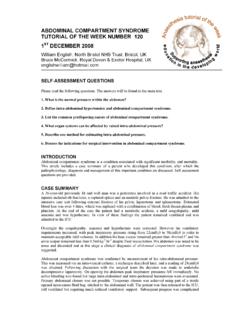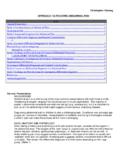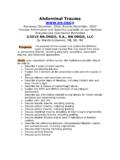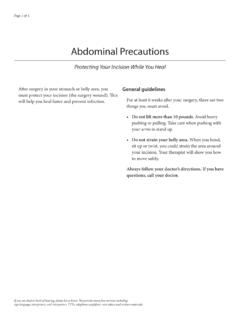Transcription of Abdominal Pain - Columbia University
1 Abdominal PAIN. Location Work-up Acute pain syndromes Chronic pain syndromes Epigastric Pain PUD. GERD. MI. AAA- Abdominal aortic aneurysm Pancreatic pain Gallbladder and common bile duct obstruction Right Upper Quadrant Pain Acute Cholecystitis and Biliary Colic Acute Hepatitis or Abscess Hepatomegaly due to CHF. Perforated Duodenal Ulcer Herpes Zoster Myocardial Ischemia Right Lower Lobe Pneumonia 1. Left Upper Quadrant Pain Acute Pancreatitis Gastric ulcer Gastritis Splenic enlargement, rupture or infarction Myocardial ischemia Left lower lobe pneumonia Right lower Quadrant Pain Appendicitis Regional Enteritis Small bowel obstruction Leaking Aneurysm Ruptured Ectopic Pregnancy PID. Twisted Ovarian Cyst Ureteral Calculi Hernia Left Lower Quadrant Pain Diverticulitis Leaking Aneurysm Ruptured Ectopic pregnancy PID. Twisted Ovarian Cyst Ureteral Calculi Hernia Regional Enteritis 2. Periumbilical Pain Disease of transverse colon Gastroenteritis Small bowel pain Appendicitis Early bowel obstruction Diffuse Pain Generalized peritonitis Acute Pancreatitis Sickle Cell Crisis Mesenteric Thrombosis Gastroenteritis Metabolic disturbances Dissecting or Rupturing Aneurysm Intestinal Obstruction Psychogenic illness Referred Pain Pneumonia (lower lobes).
2 Inferior myocardial infarction Pulmonary infarction 3. TYPES OF Abdominal PAIN. Visceral originates in Abdominal organs covered by peritoneum Colic crampy pain Parietal from irritation of parietal peritoneum Referred produced by pathology in one location felt at another location ORGANIC VERSUS FUNCTIONAL PAIN. HISTORY ORGANIC FUNCTIONAL. Pain character Acute, persistent pain Less likely to change increasing in intensity Pain localization Sharply localized Various locations Pain in relation to sleep Awakens at night No affect Pain in relation to Further away At umbilicus umbilicus Associated symptoms Fever, anorexia, Headache, dizziness, vomiting, wt loss, multiple system com- anemia, elevated ESR plaints Psychological stress None reported Present WORK-UP OF Abdominal . PAIN. HISTORY. Onset Qualitative description Intensity Frequency Location - Does it go anywhere (referred)? Duration Aggravating and relieving factors 4. WORK-UP. PHYSICAL EXAMINATION. Inspection Auscultation Percussion Palpation Guarding - rebound tenderness Rectal exam Pelvic exam WORK-UP.
3 LABORATORY TESTS. U/A. CBC. Additional depending on rule outs amylase, lipase, LFT's WORK-UP. DIAGNOSTIC STUDIES. Plain X-rays (flat plate). Contrast studies - barium (upper and lower GI series). Ultrasound CT scanning Endoscopy Sigmoidoscopy, colonoscopy 5. Common Acute Pain Syndromes Appendicitis Acute diverticulitis Cholecystitis Pancreatitis Perforation of an ulcer Intestinal obstruction Ruptured AAA. Pelvic disorders APPENDICITIS. Inflammatory disease of wall of appendix Diagnosis based on history and physical Classic sequence of symptoms Abdominal pain (begins epigastrium or periumbilical area, anorexia, nausea or vomiting followed by pain over appendix and low grade fever DIAGNOSIS. Physical examination low grade fever McBurney's point rebound, guarding, +psoas sign CBC, HCG. WBC range from 10,000-16,000. SURGERY. 6. DIVERTICULITIS. Results from stagnation of fecal material in single diverticulum leading to pressure necrosis of mucosa and inflammation Clinical presentation most pts have h/o diverticula mild to moderate, colicky to steady, aching Abdominal pain - usually LLQ.)
4 May have fever and leukocytosis PHYSICAL EXAMINATION. With obstruction bowel sounds hyperactive Tenderness over affected section of bowel DIAGNOSIS. Often made on clinical grounds CBC - will not always see leukocytosis MANAGEMENT. Spontaneous resolution common with low-grade fever, mild leukocytosis, and minimal Abdominal pain Treat at home with limited physical activity, reducing fluid intake, and oral antibiotics (bactrim DS bid or cipro 500mg bid & flagyl 500 mg tid for 7-14 days). Treatment is usually stopped when asymptomatic Patients who present acutely ill with possible signs of systemic peritonititis,, sepsis, and hypovolemia need admission CHOLECYSTITIS. Results from obstruction of cystic or common bile duct by large gallstones Colicky pain with progression to constant pain in RUQ that may radiate to R scapula Physical findings tender to palpation or percussion RUQ. may have palpable gallbladder 7. DIAGNOSIS. CBC, LFTs (bilirubin, alkaline phosphatase), serum pancreatic enzymes Plain Abdominal films demonstrate biliary air hepatomegaly, and maybe gallstones Ultrasound - considered accurate about 95%.
5 MANAGEMENT. Admission PANCREATITIS. History of cholelithiasis or ETOH abuse Pain steady and boring, unrelieved by position change - LUQ with radiation to back - nausea and vomiting, diaphoretic Physical findings;. acutely ill with Abdominal distention, BS. diffuse rebound upper abd may show muscle rigidity Diagnostic studies - CBC. - Ultrasound - Serum amylase and lipase - amylase rises 2-12 hours after onset and returns to normal in 2-3 days - lipase is elevated several days after attack Management - Admission 8. PEPTIC ULCER. PERFORATION. Life-threatening complication of peptic ulcer disease - more common with duodenal than gastric Predisposing factors Helicobacter pylori infections NSAIDs hypersecretory states Sudden onset of severe intense, steady epigasric pain with radiation to sides, back, or right shoulder Past h/o burning, gnawing pain worse with empty stomach Physical findings - epigastric tenderness - rebound tenderness - Abdominal muscle rigidity Diagnostic studies - upright or lateral decubitis X-ray shows air under the diaphragm or peritoneal cavity REFER - SURGICAL EMERGENCY.
6 SMALL BOWEL. OBSTRUCTION. Distention results in decreased absorption and increased secretions leading to further distention and fluid and electrolyte imbalance Number of causes Sudden onset of crampy pain usually in umbilical area of epigastrium - vomiting occurs early with small bowel and late with large bowel 9. Physical findings - hyperactive, high-pitched BS. - fecal mass may be palpable - Abdominal distention - empty rectum on digital exam Diagnosis - CBC. - serum amylase - stool for occult blood - type and crossmatch - Abdominal X-ray Management - Hospitalization RUPTURED AORTIC. ANEURYSM. AAA is abnormal dilation of Abdominal aorta forming aneurysm that may rupture and cause exsanguination into peritoneum More frequent in elderly Sudden onset of excrutiating pain may be felt in chest or abdomen and may radiate to legs and back . Physical findings - appears shocky - VS reflect impending shock - deficit or difference in femoral pulses Diagnosis - CT or MRI. - ECG, cardiac enzymes SURGICAL EMERGENCY.
7 10. PELVIC PAIN. Ectopic pregnancy PID. UTI. Ovarian cysts CHRONIC PAIN SYNDROMES. Irritable bowel syndrome Chronic pancreatitis Diverticulosis Gastroesophageal reflux disease (GERD). Inflammatory bowel disease Duodenal ulcer Gastric ulcer IRRITABLE BOWEL. SYNDROME. GI condition classified as functional as no identifiable structural or biochemical abnormalities Affects 14%-24% of females and 5%-19%. of males Onset in late adolescence to early adulthood Rare to see onset > 50 yrs old 11. SYMPTOMS. Pain described as nonradiating, intermittent, crampy located lower abdomen Usually worse 1-2 hrs after meals Exacerbated by stress Relieved by BM. Does not interrupt sleep critical to diagnosis of IBS. DIAGNOSIS. ROME DIAGNOSTIC CRITERIA. 3 month minimum of following symptoms in continuous or recurrent pattern Abdominal pain or discomfort relieved by BM &. associated with either: Change in frequency of stools and/or Change in consistency of stools Two or more of following symptoms on 25% of occasions/days: Altered stool frequency >3 BMs daily or <3 BMs/week Altered stool form Lumpy/hard or loose/watery Altered stool passage Straining, urgency, or feeling of incomplete evacuation Passage of mucus Feeling of bloating or Abdominal distention 12.
8 DIAGNOSTIC TESTS. Limited - R/O organic disease CBC with diff ESR. Electrolytes BUN, creatinine TSH. Stool for occult blood and O & P. Flexible sigmoidoscopy MANAGEMENT. Goals of management - exclude presence of underlying organic disease - provide support, support, & reassurance Dietary modification Pharmacotherapy Alternative therapies Physician consultation is indicated if initial treatment of IBS fails, if organic disease is suspected, and/or if the patient who presents with a change in bowel habits is over 50. 13. CHRONIC PANCREATITIS. Alcohol major cause Malnutrition - outside US. Patients >40 yrs with pancreatic dysfunction must be evaluated for pancreatic cancer Dysfunction between 20 to 40 yrs old R/O. cystic fibrosis 50% of pts with chronic pancreatitis die within 25 yrs of diagnosis SYMPTOMS. Pain - may be absent or severe, recurrent or constant Usually Abdominal , sometimes referred upper back, anterior chest, flank Wt loss, diarrhea, oily stools N, V, or Abdominal distention less reported DIAGNOSIS.
9 CBC. Serum amylase (present during acuteattacks). Serum lipase Serum bilirubin Serum glucose Serum alkaline phosphatase Stool for fecal fat CT scan 14. MANAGEMENT. Should be comanaged with a specialist Pancreatic dysfunction - diabetes - steatorrhea & diarrhea - enzyme replacement DIVERTICULOSIS. Uncomplicated disease, either asymptomatic or symptomatic Considered a deficiency disease of 20th century Western civilization Rare in first 4 decades - occurs in later years Incidence - 50% to 65% by 80 years SYMPTOMS. 80% - 85% remain symptomless - found by diagnostic study for other reason Irregular defecation, intermittent Abdominal pain, bloating, or excessive flatulence Change in stool - flattened or ribbonlike Recurrent bouts of steady or crampy pain May mimic IBS except older age 15. DIAGNOSIS. CBC. Stool for occult blood Barium enema MANAGEMENT. Increased fiber intake - 35 g/day Increase fiber intake gradually Avoid popcorn corn nuts seeds GASTROESOPHAGEAL. REFLUX DISEASE. Movement of gastric contents from stomach to esophagus May produce S & S within esophagus, pharynx, larynx, respiratory tract Most prevalent condition affecting GI tract About 15% of adults use antacid > 1x/wk 16.
10 SYMPTOMS. Heartburn - most common (severity of does not correlate with extent of tissue damage). Burning, gnawing in mid-epigastrium worsens with recumbency Water brash (appearance of salty-tasting fluid in mouth because stimulate saliva secretion). Occurs after eating may be relieved with antacids (occurs within 1 hr of eating - usually large meal of day).. Dysphagia & odynophagia predictive of severe disease Chest pain - may mimic angina Foods that may precipitate heartburn - high fat or sugar - chocolate, coffee, & onions - citrus, tomato-based, spicy Cigarette smoking and alcohol Aspirin, NSAIDS, potassium, pills DIAGNOSIS. History of heartburn without other symptoms of serious disease Empiric trial of medication without testing Testing for those who do have persistent or unresponsive heartburn or signs of tissue injury CBC, H. pylori antibody Barium swallow Endoscopy for severe or atypical symptoms 17. MANAGEMENT. Lifestyle changes smoking cessation reduce ETOH consumption reduce dietary fat decreased meal size weight reduction elevate head of bed 6 inches elimination of medications that are mucosal irritants or that lower esophageal pressure avoidance of chocolate, peppermint, coffee, tea, cola beverages, tomato juice, citrus fruit juices avoidance of supine position for 2 hours after meal avoidance of tight fitting clothes MEDICATIONS.














